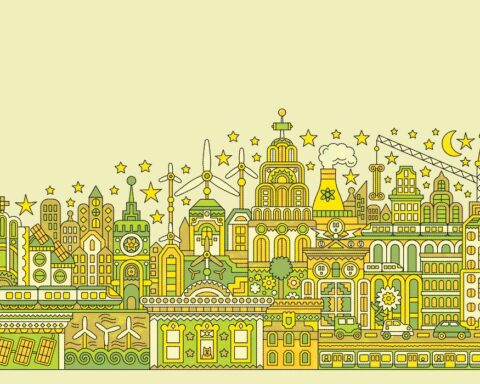Decoupling the economy from continuous growth – and from gross domestic product as the primary measure of economic and social health – is a core aim of the degrowth movement. But since it’s not an easily conjured image, how do we project this ambition into the real world? To understand life under degrowth, it’s helpful to get in touch with your feelings.
Degrowthers want an economy that benefits many more than the few and where lifestyles are less dependent on earning capacity. They want an economy where bellies feel full of cheap, local food, where bodies feel stronger from universal healthcare, and where the world feels easier to navigate because common infrastructure like public transit is more abundant and accessible. It’s a world with fewer stresses.
Omer Tayyab, an ecological economist at the University of Barcelona’s Institute of Environmental Science and Technology, describes it as a shift to “public luxury and private sufficiency.”
Degrowth offers a solution to not just a major economic problem, but a social one. For Matt Orsagh, of the Arketa Institute for Post-Growth Finance, the community focus is the selling point, as well as “less time working, more time for care, more time for your family.”
An influential degrowth movement could help stitch back together some of society’s frayed social threads, those we read about in surveys where respondents admit to identifying less with their communities than in decades past. Any fix to the climate and economic crises we’re navigating will require people to see beyond their individual needs. This is part of what makes degrowth unique: it offers a pathway to not only mitigate climate change, but to help save the community-driven part of our nature that makes us human.

What might we give up to achieve this lofty vision? For starters, industries with disproportionately high resource use might feel worth sacrificing, depending on your lifestyle. For instance, 92 million tons of fast fashion enter landfills annually, to say nothing of the electricity and oil used to produce synthetic textiles. Or how about the private jet industry? It caters to a small swath of the global population, yet in 2023 it caused about 4% of all civil aviation emissions. The cruise ship industry is another natural target, along with other sectors associated with decadence and excess, which benefit or enrich a small portion of the population.
Degrowth is also a call to scale back the sustained, upward economic growth our culture expects, from individual corporations up through entire economies. In a podcast interview, Jason Hickel, author of Less Is More: How Degrowth Will Save the World, put it this way: we tend to see efficiencies as opportunities to expand production, rather than to right-size our economy.
The shift that degrowthers propose is the antithesis of the self-focused consumer culture and workaholic grind in which most of us are steeped – and that we may not be able to physically sustain.
There are also natural limits that perpetual growth necessarily confronts. Marie-Josée Privyk, a consultant who advises companies on their ESG disclosures, uses the example of setting up new renewable-power generation. “There aren’t enough resources to generate the infrastructure required to displace all the fossil energy we are consuming,” she says. The pivot to electric cars offers an example. Yes, they produce dramatically lower emissions than their gas-powered counterparts. But according to the MIT Climate Portal, mining lithium (a non-renewable resource) for electric car batteries can unleash up to 16 tons of carbon dioxide emissions. A degrowth approach might seek to reduce the number of cars on the road and invest in mass transit.
Instead of trying to innovate our way out of crisis, a less technical approach might be necessary: a sharp cultural shift away from the consumption that propels our economic lives onward and upward and our collective mood downward.
For most of human history, we didn’t pursue growth in the way we do today. Wealth was a measure of success, but GDP became a global economic tool only 80 years ago. The more the economy grows, the greater the number of jobs and wealth. This creates resources that broadly improve the lives of citizens.
Along the way, the GDP yardstick has morphed into a different beast. “Now it’s tied up in our culture. It’s tied up in our politics, it’s tied up in our business, it’s tied up in our [retirement savings plans],” Orsagh says.
Degrowth, meanwhile, has a shorter history, taking its modern roots from the “décroissance” movement of early-2000s France. The idea took hold so strongly that former French president Nicolas Sarkozy enlisted Nobel-Prize-winning economists to head a commission that explored possible alternatives to GDP as a progress indicator. Degrowthers have many to choose from, ranging from health metrics like life expectancy or alternative indicators like the Sustainable Development Index or the World Happiness Report.
While in recent years the European Parliament, the European Union’s legislative body, has hosted two degrowth conferences, the movement has less clout in North America. That’s partly because, in Tayyab’s view, institutions like labour unions, environmentalist organizations and socialist parties are stronger in Europe, making their voices more powerful on the subject, and, in turn, making degrowth more viable. One of the leading voices in degrowth, Japanese philosopher Kohei Saito, says EU countries make more space in their economies for noncommercial activities, which is, he told Foreign Policy, “already half-degrowth.”
“[Degrowth] is well established in Europe and finds resonance with similar ideas from the Global South like Buen Vivir (Latin America), Swara (India) and Ubuntu (Africa),” Tayyab says.
Since governments operate at scale and can leverage state institutions to achieve degrowth targets, Tayyab says this power is necessary for degrowth: “The problem is that our governments during the neoliberal era have become followers of markets rather than shaping them for the people they proactively serve.”
The business world would also have to start reshaping itself for a degrowth economy, and the jury is out on how this will take shape. Some firms may keep similar models – like public health or transit agencies – while others may have to explore new business lines or corporate structures as they negotiate the balance between their own scale and profit, and the health of people and planet.
Another obstacle might be the “D-word” itself, with its negative prefix and all the attached gloomy presumptions, like the fears of austerity or Luddism that boosters say are extreme reactions. Degrowth is less a regression than a reallocation of economic energies, they argue. “There’s still going to be things that grow, but let’s not grow the things that are destroying us or life-support systems,” says Christopher F. Jones, a historian of environment, economics and energy at Arizona State University.
But degrowthers exist on a wide spectrum, and they advocate for a lot of different things. Politicians and business owners may, because of competing interests, draw their limits to keep political donors happy or preserve profits, but everyday boosters frame degrowth in their own image too.

Some supporters apply degrowth ideals with relative conservatism. The economy they want to live in might end up more like a steady-state economy, which values improvement over expansion and focuses on optimizing resources. Others take a more radical approach, pontificating on burning the capitalist system down and starting over in a socialist (if not communist) utopia. This reset strategy must be dismissed as it offers no real plan for incremental improvements. Lives improve only if and when utopia is found. Environmental crises and lifestyle challenges would compound in the meantime.
For a movement selling itself to a skeptical public, having wildly different visions of degrowth exist in the same conversation is a marketing nightmare. Conversations about degrowth sometimes conflate it with “doughnut economics,” a regenerative economic model designed to account for environmental limits. Shaped like the pastry, the doughnut model has an inner ring of basic human needs but with the ecological ceiling as the outer ring, finding a balance in the space between for the well-being of people and planet. Degrowth boosters also increasingly use “postgrowth” and “degrowth” interchangeably, despite them previously being treated as more distinct concepts.
Orsagh, who writes a newsletter on degrowth but whose institute has “postgrowth” in the title, sees the former as a tool to get to the latter. “Degrowth isn’t a replacement for capitalism,” he says. “It’s what the path is to whatever comes next.”
North America represents a final frontier of sorts for degrowth. “In Canada, there doesn’t yet exist a strong enough political force that can articulate these demands,” Tayyab says.
Even so, in some niche areas, degrowth policies are taking hold in Canada and abroad – mostly related to reducing the time spent at work.
The right to disconnect, a policy that allows employees to ignore work-related emails and calls outside of their contracted hours, is one example of the trend. In Canada, it is already law in Ontario for firms with 25 or more employees. The federal government may soon enforce such a law for regulated industries, such as banking. At least a dozen nations have versions of similar regulations on the books.
Four-day workweeks and universal basic income, two other policies in this vein, are also increasingly becoming part of economic conversations, shifting away from traditional ideas of growth, productivity and work–life balance. Multiple countries, Canada included, explored basic income supports through a suite of emergency benefits during the COVID-19 pandemic. They were successful in untangling the ability to live with dignity from labour value and lifting people from poverty. In Canada, the percentage of Canadians living in poverty dropped from 10.3% in 2019 to 6.4% in 2020. One analysis found the assistance sufficient to move a single person out of poverty even in pricey Toronto. Such pandemic relief also led to record low poverty in the United States in 2023. Both countries lost this momentum after the policies lapsed, with rates creeping up.
Jones, who recently authored The Invention of Infinite Growth, thinks promoting the idea of a well-being economy, instead of hammering against GDP, can help degrowth make inroads. “Not every culture has to define well-being the same way, but everyone could agree we want to pursue it,” he says.
It’s an idealistic future to hope for, but that isn’t a criticism. Degrowth may be at odds with today’s economy, but it’s not necessarily at odds with a world we’d enjoy living in or one where we make faster progress toward tackling the climate crisis. It may seem disconnected from reality, but that’s a failure of imagination, and imagination is precisely what we need to move forward – to look at what we have at our disposal and get creative, rather than push it any further beyond its limits.
Rob Csernyik is a freelance journalist specializing in business and investigative reporting, as well as long-form features.
The Weekly Roundup
Get all our stories in one place, every Wednesday at noon EST.





